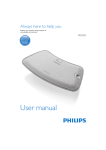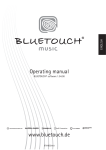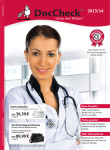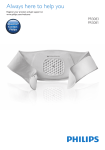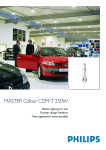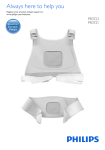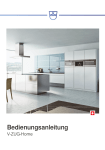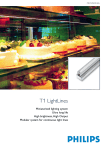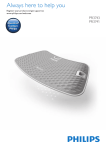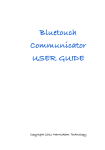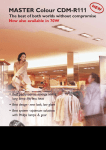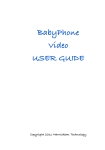Download Bedienungsanleitung Philips PR3082
Transcript
Register your product and get support at
www.philips.com/welcome
PRP6100/02
23
DEUTSCH 6
PRP6100/02
ENGLISH 27
6
DEUTSCH
Table of contents
Einführung 6
Wichtig 6
Allgemeine Beschreibung 15
Laden 15
Das BlueTouch Pain Relief Patch verwenden 17
Reinigung 23
Umwelt 23
Garantie und Kundendienst 24
Fehlerbehebung 24
Technische Daten 25
Einführung
Lesen Sie diese Bedienungsanleitung aufmerksam durch, bevor Sie
das BlueTouch Pain Relief Patch anwenden, und bewahren Sie sie für
den späteren Gebrauch auf. Dieses medizintechnische Gerät ist nicht
YHUVFKUHLEXQJVSÁLFKWLJ)URSWLPDOH%HKDQGOXQJVHUJHEQLVVHLVWHV
erforderlich, das Gerät gemäß dem Behandlungsplan und den Anweisungen
in dieser Bedienungsanleitung anzuwenden. Sollten Sie weitere Fragen
haben, wenden Sie sich bitte an Ihren Apotheker.
BlueTouch ist eine Marke von Koninklijke Philips N.V.
Verwendungszweck
Das BlueTouch Pain Relief Patch ist ein tragbares medizintechnisches
Gerät, das zur Behandlung von Rückenschmerzen während der normalen
täglichen Aktivitäten konzipiert wurde. Die Behandlung erfolgt durch die
Anwendung von Licht und Wärme am Körper. Spezielles blaues LED-Licht
entspannt geschädigte Muskeln und unterstützt deren Regenerierung
durch eine verbesserte Durchblutung. Das BlueTouch Pain Relief Patch
wurde zur Verwendung am oberen und/oder unteren Rücken entwickelt
und lässt sich dank eines textilen Rückenbands nach Bedarf an die jeweilige
Behandlungsstelle anlegen. Das Gerät wird durch integrierte, nicht
austauschbare Akkus betrieben. Das BlueTouch Pain Relief Patch sollte nur
von Personen über 18 Jahren verwendet und bedient werden. Es sollte
ausschließlich gemäß den Sicherheitshinweisen und den Anweisungen
in dieser Bedienungsanleitung verwendet sowie für den Zweck genutzt
werden, für den es entwickelt wurde.
Wichtig
Wichtige Sicherheitshinweise
Gefahr
- Halten Sie den Adapter trocken.
Warnhinweis
- Tauchen Sie das BlueTouch Pain Relief Patch nicht in Wasser, und spülen
6LHHVQLFKWXQWHUÁLHHQGHP:DVVHUDE
- Verwenden Sie das BlueTouch Pain Relief Patch nicht in feuchter
Umgebung.
DEUTSCH
-
7
Das BlueTouch Pain Relief Patch sollte nicht von Personen unter
18 Jahren und von Personen mit eingeschränkten physischen,
sensorischen oder psychischen Fähigkeiten verwendet werden.
DIES IST EIN MEDIZINTECHNISCHES GERÄT. HALTEN SIE DAS
GERÄT AUSSERHALB DER REICHWEITE VON KINDERN.
Lassen Sie Kinder nicht mit dem BlueTouch Pain Relief Patch spielen.
Befolgen Sie stets den Behandlungsplan im Kapitel “Das BlueTouch
Pain Relief Patch verwenden”. Verwenden Sie das Gerät nicht mehr als
zweimal täglich.
Laden Sie das BlueTouch Pain Relief Patch nur mit dem mitgelieferten
Adapter oder mit einem Micro-USB-Kabel (Letzteres ist nicht im
Lieferumfang enthalten) auf.
Prüfen Sie das BlueTouch Pain Relief Patch und den Adapter vor jedem
Gebrauch auf Schäden.
Verwenden Sie das BlueTouch Pain Relief Patch bzw. den Adapter nicht,
wenn Schäden vorhanden sind.
Wenn der Adapter beschädigt ist, ersetzen Sie ihn nur durch einen
Original-Adapter, um Gefährdungen zu vermeiden. Wenden Sie sich an
Philips, wenn Sie einen neuen Adapter benötigen.
Der Adapter enthält einen Transformator. Ersetzen Sie den
Adapter keinesfalls durch einen anderen Stecker, da dies eine
Gefährdungssituation darstellt.
Verbinden Sie den Adapter des BlueTouch Pain Relief Patch nicht
mit einem Verlängerungskabel oder einer Mehrfachsteckdose, um
Gefährdungen zu vermeiden.
1HKPHQ6LHNHLQH0RGLÀ]LHUXQJHQDP%OXH7RXFK3DLQ5HOLHI3DWFK
und an seinen Zubehörteilen vor.
Berühren Sie den Sensor in der Mitte des BlueTouch Pain Relief Patch
nicht absichtlich, wenn das Patch eingeschaltet ist.
Platzieren Sie keine Objekte auf dem Sensor in der Mitte des
BlueTouch Pain Relief Patch, wenn das Patch eingeschaltet ist.
Lassen Sie das BlueTouch Pain Relief Patch nicht unbeaufsichtigt, wenn
HVHLQJHVFKDOWHWLVWRGHUDXÁlGW
Wenden Sie sich zur Prüfung oder zur Reparatur des BlueTouch
Pain Relief Patch immer an ein Philips Service-Center. Unsachgemäß
ausgeführte Reparaturen können den Benutzer gefährden.
Achtung
- Das BlueTouch Pain Relief Patch wurde speziell zur Behandlung
von Rückenschmerzen während der normalen täglichen Aktivitäten
entwickelt, wie beispielsweise Arbeiten am Computer, Lesen, Fernsehen
oder Arbeiten im Garten oder im Haus, wie z. B. Kochen. Verwenden
Sie es ausschließlich für die Behandlung von Rückenschmerzen und
nicht für andere Zwecke.
- Wenn die Behandlung unangenehm wird, wechseln Sie in einen
niedrigeren Behandlungsmodus. Sollte die Behandlung auch im
niedrigen Modus noch unangenehm sein, schalten Sie das BlueTouch
Pain Relief Patch aus, und beenden Sie die Anwendung.
- Üben Sie nie übermäßigen Druck auf das BlueTouch Pain Relief Patch
aus, z. B. durch Drücken oder indem Sie darauf liegen, sitzen oder
stehen. Lehnen Sie sich beim Sitzen nicht zu sehr gegen das BlueTouch
Pain Relief Patch.
8
DEUTSCH
-
-
-
-
Verwenden Sie das BlueTouch Pain Relief Patch nur mit einem der
speziell von Philips entwickelten Rückenbänder. Die Rückenbänder sind
nicht im Lieferumfang enthalten und müssen separat erworben werden.
Setzen Sie das BlueTouch Pain Relief Patch keinen schweren Stößen
aus, und lassen Sie es nicht fallen.
Drücken Sie das BlueTouch Pain Relief Patch nicht zusammen, und
verdrehen Sie es nicht.
Halten Sie das BlueTouch Pain Relief Patch fern von scharfen, spitzen
oder scheuernden Objekten.
Tragen Sie das BlueTouch Pain Relief Patch nicht während des
$XÁDGHQV
Verwenden Sie vor der Behandlung keine Cremes oder Körperlotionen
auf der Haut.
Das blaue Licht kann Tätowierungen im Anwendungsbereich verfärben.
$FKWHQ6LHEHLGHU9HUZHQGXQJGHP$XÁDGHQXQGGHU$XIEHZDKUXQJ
des BlueTouch Pain Relief Patch auf eine Temperatur von +10 °C bis
+35 °C und eine relative Luftfeuchtigkeit von 30 bis 90 %.
Wenn Sie das BlueTouch Pain Relief Patch von einer sehr warmen in
eine kältere Umgebung bringen, warten Sie etwa 3 Stunden, bevor Sie
das Gerät nutzen.
Blicken Sie nicht direkt in das vom BlueTouch Pain Relief Patch
abgegebene Licht, wenn das Patch eingeschaltet ist.
Verwenden Sie das BlueTouch Pain Relief Patch nicht bei Fieber, bei
Krankheit oder wenn Sie Medikamente einnehmen bzw. Kosmetika
verwenden, die in Kombination mit dem BlueTouch Pain Relief Patch
unerwünschte Hautreaktionen verursachen könnten. Lesen Sie den
$EVFKQLWW´*HJHQDQ]HLJHQµLQGLHVHP.DSLWHOXPKHUDXV]XÀQGHQRE
dies auf Sie zutrifft, bevor Sie mit der Anwendung des BlueTouch Pain
Relief Patch beginnen.
Um das BlueTouch Pain Relief Patch vom Netzstrom zu trennen,
nehmen Sie den Adapter aus der Steckdose.
Das BlueTouch Pain Relief Patch ist nicht für den unterbrochenen
Gebrauch gedacht. Die genaue Anwendungszeit wird in Kapitel “Das
BlueTouch Pain Relief Patch verwenden”, Abschnitt “Behandlungsmodi,
Dauer und Intensität” erklärt.
Installieren Sie das BlueTouch Pain Relief Patch immer gemäß den
Anweisungen in dieser Bedienungsanleitung. Vergewissern Sie sich,
dass drahtlose Kommunikationsgeräte, wie zum Beispiel drahtlose
Heimnetzwerkrouter, Mobiltelefone, schnurlose Telefone und ihre
Basisstationen sowie Walkie-Talkies mindestens 6,7 Meter vom
BlueTouch Pain Relief Patch entfernt sind, das diese Geräte die
)XQNWLRQVWFKWLJNHLWGHV3DWFKHVEHHLQÁXVVHQN|QQHQ
Reinigen Sie den Infrarot-Sensor mit einem feuchten Tuch nach
jeder Behandlung, um auch zukünftig eine ordnungsgemäße Funktion
sicherzustellen.
Um Schaden an der Waschmaschinentrommel oder an anderer
Wäsche in der Trommel zu verhindern, waschen Sie die Rückenbänder
in einem feinmaschigen Wäschesack.
DEUTSCH
9
Gegenanzeigen
Verwenden Sie das BlueTouch Pain Relief Patch nicht in folgenden
Situationen:
- Wenn Sie Hautverbrennungen oder einen Sonnenbrand haben.
- Wenn Sie Fieber haben.
- Wenn Sie eine bekannte Sonnenallergie haben.
- :HQQ6LHDOOHUJLVFKDXIGLH2EHUÁlFKHQPDWHULDOLHQGHV%OXH7RXFK3DLQ
5HOLHI3DWFK3RO\XUHWKDQIUGLH+DXWNRQWDNWÁlFKH(GHOVWDKOIUGHQ
,QIUDURW6HQVRUXQGHLQH3RO\DPLG(ODVWDQPLVFKXQJIUGLH2EHUÁlFKH
die die Haut nicht berührt) oder auf die DriRelease Polyester-/
Baumwollmischung der Rückenbänder reagieren.
- Wenn Sie unter einer bekannten Krankheit oder idiopathischen
Hauterkrankung, wie z. B. Porphyrie, polymorphe Licht-Dermatose,
chronische aktinische Dermatitis, aktinische Prurigo oder Lichturtikaria,
GLH/LFKWHPSÀQGOLFKNHLWYHUXUVDFKWOHLGHQ
- Wenn Sie unter aktivem Hautkrebs leiden oder in der Vergangenheit an
den zu behandelnden Hautpartien unter Hautkrebs oder einer anderen
Krebsart gelitten haben; das Gleiche gilt bei präkanzerösen Läsionen
und großen Muttermalen.
- Wenn Sie fotosensibilisierende Medikamente einnehmen, prüfen Sie
den Beipackzettel, und verwenden Sie das Gerät auf keinen Fall, wenn
als Nebenwirkungen fotoallergische oder fototoxische Reaktionen
auftreten können oder Ihre Haut während der Einnahmezeit nicht
direktem Sonnenlicht ausgesetzt werden darf.
- Wenn Sie Steroide einnehmen. Durch diese Medikamente wird die
+DXWUHL]HPSÀQGOLFKHU
- Wenn Sie an den zu behandelnden Hautpartien Infektionen, Ekzeme,
noch nicht abgeheilte Tätowierungen, Verbrennungen, entzündete
)ROOLNHORIIHQH:XQGHQ$EVFKUIXQJHQ+HUSHV6FKXSSHQÁHFKWH
Wunden oder Läsionen und Blutergüsse haben.
- Wenn Sie schwere oder nicht eingestellte Diabetes oder Diabetes mit
peripheren Schäden haben.
- Wenn Sie unkontrollierte arterielle Hypertonie haben oder bereits
in der Vergangenheit einen Schlaganfall, Herzinfarkt, Angina pectoris,
arteriosklerotische Herz-Kreislauf-Erkrankungen oder periphere
vaskuläre Erkrankungen erlitten haben.
- Wenn Sie schwanger sind oder stillen.
- Wenn Sie eine entzündliche Erkrankung haben, die Schmerzen
verursacht, oder eine andere chronische Krankheit oder
bekannte Infektion, die Schmerzen verursacht, wie zum Beispiel
Spondylarthropathie, rheumatische Arthritis, Lupus erythematodes
oder Lyme-Borreliose.
- Wenn Sie an einer degenerativen Erkrankung des Nervensystems, wie
zum Beispiel Multiple Sklerose oder Parkinson-Krankheit, oder an einer
Spinalkanalstenose, die Rückenschmerzen unterstützt oder verursacht,
am Cauda equina-Syndrom oder an anderen neurologischen
Symptomen leiden, die auf eine Neuropathie hinweisen.
- Wenn Sie an Schizophrenie, am Borderline-Syndrom oder an schweren
Depressionen leiden.
- Wenn Sie an sensorischer Deprivation leiden oder wenn Gürtelrose
oder postherpetische Neuralgie, insbesondere im mittleren
Rumpfbereich, diagnostiziert wurde.
10
DEUTSCH
-
-
Wenn Sie anatomische Symptomatiken oder andere physische
Einschränkungen haben, die ein Anlegen des BlueTouch Pain Relief
Patch nicht möglich machen.
Wenn Sie ein aktives, implantiertes Gerät haben, wie zum
%HLVSLHOHLQHQ+HU]VFKULWWPDFKHUHLQHQ'HÀEULOODWRUHLQHQ
Neurostimulator, ein Cochlea-Implantat oder ein aktives Gerät zur
Medikamentenverabreichung.
Wenn Sie in der Vergangenheit an schwerer Osteoporose (T-Wert
von 2,5 und ein oder mehrere Knochenbrüche) oder an einer anderen
schweren Knochenkrankheit gelitten haben.
Wenn Sie in den vorangehenden 8 Wochen eine akute Verrenkung
oder einen akuten Bruch hatten.
Wenn Sie in den vorangehenden 8 Wochen an postoperativen
Rückenproblemen gelitten haben oder an Oberkörper, Kopf oder
Rücken operiert wurden.
Wenn Sie an Ganzkörperschmerzen leiden.
Wenn Ihr allgemeiner Gesundheitszustand schlecht ist.
Normerfüllung
-
Das BlueTouch Pain Relief Patch erfüllt sämtliche relevante Normen
für elektrische Medizingeräte und Geräte für den Heimgebrauch, die
optische (LED-)Strahlung nutzen.
Das BlueTouch Pain Relief Patch erfüllt sämtliche Normen bezüglich
elektromagnetischer Felder (EMF). Nach aktuellen wissenschaftlichen
Erkenntnissen ist das BlueTouch Pain Relief Patch sicher im Gebrauch,
sofern es ordnungsgemäß und entsprechend den Anweisungen in
dieser Bedienungsanleitung gehandhabt wird.
Erklärung der Symbole
BlueTouch Pain Relief Patch
- Dieses Symbol bedeutet: Entspricht den EG-Richtlinien. CE steht für
“Conformité Européenne”.
-
Dieses Symbol bedeutet: Das BlueTouch Pain Relief Patch nicht in der
Waschmaschine waschen.
DEUTSCH
11
-
Dieses Symbol bedeutet, dass das Gerät spritzwasserfest ist.
-
Dieses Symbol kennzeichnet ein Geräteteil vom Typ BF (Body Floating).
-
Dieses Symbol bedeutet: Blicken Sie nicht direkt ins Licht. Risikogruppe
1 Produkt.
-
Dieses Symbol ist ein Warnhinweis, die mitgelieferten Dokumente
vor dem Gebrauch des Geräts zu lesen, und alle erforderlichen
Sicherheitsmaßnahmen zu treffen.
-
Dieses Symbol bedeutet: Lesen Sie die Bedienungsanleitung durch,
bevor Sie das BlueTouch Pain Relief Patch verwenden.
12
DEUTSCH
-
'LHVHV6\PEROEHGHXWHW1LFKWXQWHUÁLHHQGHP:DVVHUUHLQLJHQ
-
Dieses Symbol bedeutet: Blicken Sie nicht in die Lichtquelle.
Risikogruppe 1 Produkt (IEC60601-2-57:2011).
-
Dieses Symbol bedeutet: Nicht mit dem normalen Hausmüll entsorgen.
Weitere Anweisungen erhalten Sie im Kapitel “Umwelt”.
-
Dieses Symbol zeigt die Bereiche an, in denen das BlueTouch Pain
Relief Patch positioniert und angewendet werden kann.
-
Dieses Symbol bedeutet “Hergestellt von” und wird gemeinsam mit
dem Philips Logo und der Wortmarke dargestellt.
DEUTSCH
13
Adapter
- Dieses Symbol bedeutet, dass der Adapter zweifach isoliert ist
(Klasse II).
-
Dieses Symbol bedeutet, dass der Adapter nur im Haus verwendet
werden darf.
-
'LHVHV6\PEROEHGHXWHW1LFKWXQWHUÁLHHQGHP:DVVHUUHLQLJHQ
-
Dieses Symbol bedeutet: Nicht mit dem normalen Hausmüll entsorgen.
Weitere Anweisungen erhalten Sie im Kapitel “Umwelt”.
Rückenbänder
- Dieses Symbol bedeutet: Bei einer Temperatur von maximal 30 Grad
Celsius waschen.
14
DEUTSCH
4659CIT
-
Dieses Symbol bedeutet: Nicht bleichen.
-
Dieses Symbol bedeutet: Nicht im Trockner trocknen.
-
Dieses Symbol bedeutet: Nicht bügeln.
-
Dieses Symbol bedeutet: Nicht chemisch reinigen.
-
Dieses Symbol bedeutet, dass das Material auf schädliche Stoffe gemäß
Öko-Tex® Standard 100 geprüft worden ist.
DEUTSCH
15
-
Dieses Symbol bedeutet, dass dieses Rückenband zur Verwendung am
unteren Rücken geeignet ist.
-
Dieses Symbol bedeutet, dass dieses Rückenband zur Verwendung am
oberen Rücken geeignet ist.
Allgemeine Beschreibung (Fig. 23)
1
2
3
4
5
6
7
8
9
10
11
BlueTouch Pain Relief Patch (außen)
Anschlussfeld
Anschluss für den kleinen Adapterstecker
Ladeanzeige
Micro-USB-Buchse
Modus-Taste
BlueTouch Pain Relief Patch (Hautseite)
Anwendungsbereich
Infrarot-Sensor
Adapter
Gerätestecker
Laden
Laden Sie das BlueTouch Pain Relief Patch bei niedrigem Akkustand und bei
der Erstanwendung des Geräts vollständig auf. Wenn das BlueTouch Pain
Relief Patch vollständig aufgeladen ist, kann es 120 Behandlungsminuten
lang angewendet werden. Sie können das BlueTouch Pain Relief Patch mit
dem mitgelieferten Adapter oder durch Anschließen eines Micro-USBKabels (Letzteres ist nicht im Lieferumfang enthalten) an die Micro-USB%XFKVHDXÁDGHQ
Hinweis: Die Behandlung ist nicht möglich, wenn das BlueTouch Pain Relief
Patch gerade aufgeladen wird.
0LWGHP$GDSWHUDXÁDGHQ
(LQYROOVWlQGLJHV$XÁDGHQGHV%OXH7RXFK3DLQ5HOLHI3DWFKPLWGHP
Adapter dauert 2,5 Stunden.
1 Öffnen Sie die Abdeckung des Anschlussfelds.
2 Stecken Sie den kleinen Stecker des Adapters in den entsprechenden
Anschluss des BlueTouch Pain Relief Patch.
16
DEUTSCH
3 Stecken Sie den Adapter in die Steckdose (100 V-240 V).
, Wenn der kleine Stecker ordnungsgemäß verbunden ist, piepst das
BlueTouch Pain Relief Patch einmal und zeigt damit an, dass das
$XÁDGHQEHJRQQHQKDW
,
Die Ladeanzeige auf dem Anschlussfeld blinkt langsam und regelmäßig
während das BlueTouch Pain Relief Patch aufgeladen wird.
4 Sobald das BlueTouch Pain Relief Patch vollständig aufgeladen ist,
leuchtet die Ladeanzeige ununterbrochen.
5 Nehmen Sie den Adapter aus der Steckdose, und ziehen Sie den
kleinen Stecker aus dem Anschluss des BlueTouch Pain Relief Patch.
0LWGHP0LFUR86%$QVFKOXVVDXÁDGHQ
Sie können das BlueTouch Pain Relief Patch auch mit einem Micro-USB.DEHODXÁDGHQ'LHVHV.DEHOLVWQLFKWLP/LHIHUXPIDQJGHV%OXH7RXFK3DLQ
5HOLHI3DWFKHQWKDOWHQ'DV$XÁDGHQPLWHLQHP0LFUR86%.DEHONDQQELV
zu 8 Stunden in Anspruch nehmen.
1 Öffnen Sie die Abdeckung des Anschlussfelds.
2 Stecken Sie den Stecker des Micro-USB-Kabels in den USB-Anschluss
des BlueTouch Pain Relief Patch.
3 Stecken Sie den anderen Stecker des Micro-USB-Kabels in ein USBLadegerät oder Ihren Computer.
, Wenn das Micro-USB-Kabel ordnungsgemäß verbunden ist, piepst
das BlueTouch Pain Relief Patch einmal und zeigt damit an, dass das
$XÁDGHQEHJRQQHQKDW
DEUTSCH
,
17
Die Ladeanzeige auf dem Anschlussfeld blinkt langsam und
kontinuierlich während das BlueTouch Pain Relief Patch aufgeladen
wird.
4 Sobald die Akkus des BlueTouch Pain Relief Patch vollständig
aufgeladen sind, leuchtet die Ladeanzeige ununterbrochen.
5 Ziehen Sie den Stecker des Micro-USB-Kabels aus dem Micro-USBAnschluss des BlueTouch Pain Relief Patch.
Das BlueTouch Pain Relief Patch verwenden
Behandlungsplan
Halten Sie sich stets an den unten angegebenen Behandlungsplan.
Verwenden Sie das Gerät nicht mehr als zweimal täglich.
Das BlueTouch Pain Relief Patch wurde für den täglichen Gebrauch
entwickelt. Sie können es immer dann verwenden, wenn Sie Schmerzen
verspüren. Es ist jedoch wichtig, dass Sie sich an den unten angegebenen
Behandlungsplan halten und nicht mehr als zweimal täglich anwenden.
Wenn Sie sich an den unten angegebenen Plan halten, wird die maximale
tägliche Lichtdosis von 90 J/cm² nicht überschritten.
Behandlungsoptionen
Die folgenden Behandlungsoptionen sind möglich:
- Zwei Behandlungen des unteren Rückens pro Tag
- Zwei Behandlungen des oberen Rückens pro Tag
- Eine Behandlung des unteren Rückens und eine Behandlung des
oberen Rückens pro Tag
Hinweis: Sie können das BlueTouch Pain Relief Patch zweimal hintereinander
für zwei Behandlungen von 15 Minuten, 20 Minuten oder 30 Minuten
verwenden, mit einer kurzen Unterbrechung zwischen den Behandlungen.
Drücken Sie die Bedienungstaste, um das Gerät wieder einzuschalten.
18
DEUTSCH
Behandlungsmodi, Dauer und Intensität
Stufen
Anzahl Behandlungen pro Tag und
Behandlungsdauer
Intensität
1: Niedrig
2 x 30 Min.
50 %
2: Mittel
2 x 20 Min.
75 %
3: Hoch
2 x 15 Min.
100 %
Behandlungsmodi
Behandlungsmodi auswählen
Das BlueTouch Pain Relief Patch hat drei Modi und eine AUS-Einstellung.
Drücken Sie die Modus-Taste einmal oder mehrmals, um einen der drei
Behandlungsmodi auszuwählen. Wenn Sie die Modus-Taste ein viertes Mal
drücken, schalten Sie das BlueTouch Pain Relief Patch aus.
1 Modus 1 (Niedrig): Einmal drücken
2 Modus 2 (Mittel): Zweimal drücken
3 Modus 3 (Hoch): Dreimal drücken
4 O (AUS): Viermal drücken
Hinweis:Wenn Sie von Modus 3 zu Modus 1 oder 2 oder von Modus 2 zu
Modus 1 wechseln möchten, drücken Sie die Modus-Taste so oft wie nötig, um
den gewünschten Modus auszuwählen.Wenn Sie die Taste nicht innerhalb von
2 Sekunden so oft wie nötig drücken, piepst das BlueTouch Pain Relief Patch
zweimal und schaltet sich aus.
Hinweis:Wenn Sie innerhalb von 2 Sekunden einen anderen Modus auswählen,
wird die Behandlungszeitschaltuhr nicht auf die Behandlung mit dem neu
ausgewählten Modus zurückgesetzt. Stattdessen zählt die Zeitschaltuhr ab
dem Zeitpunkt, an dem Sie zum anderen Modus geschaltet haben, weiterhin
zurück. Dies bedeutet, dass die restliche Behandlungsdauer für die Intensität
und die Behandlungsdauer des neu ausgewählten Modus erneut berechnet
wird.Wenn Sie beispielsweise von Modus 3 zu Modus 1 schalten, und die
restliche Behandlungsdauer in Modus 3 bei 5 Minuten liegt, beträgt die
restliche Behandlungsdauer in Modus 1 10 Minuten. In Modus 1 ist die
Intensität 50 % geringer als die Intensität in Modus 3. Dies bedeutet, dass die
Behandlung in Modus 1 zweimal länger als in Modus 3 dauert.
Behandlungsintensität
, In Modus 1 (Niedrig) leuchten zwei LED-Reihen auf. Das BlueTouch
Pain Relief Patch piepst einmal.
, In Modus 2 (Mittel) leuchten vier LED-Reihen auf. Das BlueTouch
Pain Relief Patch piepst zweimal.
,
In Modus 3 (Hoch) leuchten sechs LED-Reihen auf. Das BlueTouch
Pain Relief Patch piepst dreimal.
Hinweis:Wenn Sie einen Modus auswählen, wird das BlueTouch Pain Relief
Patch zunächst im Augenschutzmodus eingeschaltet. In diesem Modus
leuchten die LEDs mit einer niedrigen Lichtintensität, die für die Augen nicht
schädlich ist. Das BlueTouch Pain Relief Patch schaltet zur Intensität des
Modus, den Sie ausgewählt haben, sobald der Sensor Hautkontakt misst.
DEUTSCH
19
Das BlueTouch Pain Relief Patch für den Gebrauch vorbereiten
Am besten befestigen Sie das Pain Relief Patch mit einem der
Rückenbänder am Körper. Ein Band ist speziell für die Behandlung des
oberen Rückens und eins für die Behandlung des unteren Rückens
vorgesehen.
Hinweis:Tragen Sie nicht mehrere Schichten Kleidung bzw. enge oder dicke
Kleidung über dem BlueTouch Pain Relief Patch, um ein vorzeitiges Ausschalten
des Geräts zu vermeiden.Wenn Sie zu enge oder dicke Kleidung tragen, misst
der Infrarot-Sensor eine zu hohe Temperatur, und das Gerät wird ausgeschaltet.
Das Rückenband für den unteren Rücken anlegen
Um das BlueTouch Pain Relief Patch in das Rückenband einzulegen,
befolgen Sie die unten beschriebenen Schritte.
1 Legen Sie das Rückenband für den unteren Rücken und das
BlueTouch Pain Relief Patch vor sich auf einen Tisch. Schieben Sie die
linke Seite des BlueTouch Pain Relief Patch hinter den elastischen
Rand der Gurtöffnung.
2 Schieben Sie dann das andere Ende des BlueTouch Pain Relief Patch
so hinter den gegenüberliegenden elastischen Rand der Öffnung,
dass sich das gesamte Patch im Rückenband für den unteren Rücken
EHÀQGHW9HUJHZLVVHUQ6LHVLFKGDVVGLH/('VQLFKWYRP0DWHULDOGHV
Rückenbands bedeckt werden.Verschieben Sie das BlueTouch Pain
Relief Patch gegebenenfalls etwas.
3 Entfernen Sie alle Kleidung von der zu behandelnden Körperpartie.
Hinweis:Vergewissern Sie sich, dass die Haut im zu behandelnden Bereich
sauber und vollständig trocken ist, und dass dort keine Cremes, Körperlotionen
oder andere Kosmetika aufgetragen wurden.
4 Wickeln Sie das Rückenband für den unteren Rücken mit dem
BlueTouch Pain Relief Patch so um Ihre Taille, dass die Öffnung des
Bands zum Rücken zeigt.
5 Befestigen Sie es mit den Klettverschlüssen an beiden Enden des
Rückenbands.
Hinweis:Vergewissern Sie sich, dass sich das BlueTouch Pain Relief Patch im
5FNHQEDQGDXIGHU]XEHKDQGHOQGHQ.|USHUSDUWLHEHÀQGHWXQGGHU/('
Bereich Hautkontakt hat.
Das Rückenband für den oberen Rücken anlegen
1 Um das BlueTouch Pain Relief Patch im Rückenband für den oberen
Rücken anzubringen, gehen Sie wie in den Schritten 1 und 2 im
Abschnitt “Das Rückenband für den unteren Rücken anlegen” vor.
2 Entfernen Sie alle Kleidung von der zu behandelnden Körperpartie.
Hinweis:Vergewissern Sie sich, dass die Haut im zu behandelnden Bereich
sauber und vollständig trocken ist, und dass dort keine Cremes, Körperlotionen
oder andere Kosmetika aufgetragen wurden.
20
DEUTSCH
3 Legen Sie das Rückenband für den oberen Rücken so auf Ihren
Rücken, dass die Öffnung zum Rücken zeigt.
Hinweis:Vergewissern Sie sich, dass sich das BlueTouch Pain Relief Patch im
5FNHQEDQGDXIGHU]XEHKDQGHOQGHQ.|USHUSDUWLHEHÀQGHWXQGGHU/('
Bereich Hautkontakt hat.
4 Schließen Sie den Taillengurt mit den Klettverschlüssen, und
befestigen Sie die Schultergurte mit den Klettverschlüssen an beiden
Teilen des Taillengurts.
Hinweis: Sie können die Schultergurte auch über Kreuz befestigen. In einigen
Situationen kann dies eine günstigere Lösung sein.
Behandlungsverfahren
1 Drücken Sie die Modus-Taste einmal oder mehrmals, um einen der
drei Behandlungsmodi auszuwählen.
2 Wenn Sie den Behandlungsmodus ausgewählt haben (siehe Abschnitt
“Behandlungsmodi auswählen” in diesem Kapitel), werden die LEDs
des ausgewählten Modus im Augenschutzmodus eingeschaltet.
3 Die Behandlung beginnt, nachdem das BlueTouch Pain Relief
Patch die Haut berührt und der Sensor des Patch mindestens fünf
Sekunden lang eine Temperatur von mindestens +33 °C misst.
, Alle LEDs des ausgewählten Modus leuchten mit voller Stärke.
DEUTSCH
21
Berühren Sie den Sensor in der Mitte des BlueTouch Pain Relief Patch
nicht absichtlich, wenn das Patch eingeschaltet ist.
Hinweis: Sie können das Rückenband auch auf den Rücken legen und dann die
Bedienungstaste drücken, um den Behandlungsmodus auszuwählen. In diesem
Fall wird das BlueTouch Pain Relief Patch innerhalb von fünf Sekunden im
ausgewählten Modus eingeschaltet.
4 Das BlueTouch Pain Relief Patch schaltet sich nach der
Behandlungsdauer im ausgewählten Modus automatisch aus. Weitere
,QIRUPDWLRQHQ]XU%HKDQGOXQJVGDXHUÀQGHQ6LHLP$EVFKQLWW
“Behandlungsplan”.
Die Behandlung unterbrechen
1 Wenn Sie die Behandlung kurz unterbrechen möchten, nehmen Sie
das BlueTouch Pain Relief Patch einfach ab.
, Die LEDs des BlueTouch Pain Relief Patch schalten automatisch
zurück in den Augenschutzmodus.
Achtung: Blicken Sie nicht direkt in das von den LEDs abgegebene
Licht, selbst wenn die LEDs im Augenschutzmodus leuchten und die
Behandlung unterbrochen wurde.
Hinweis: Nach 10 Minuten im Augenschutzmodus schaltet sich das BlueTouch
Pain Relief Patch automatisch aus.
2 Um die Behandlung nach einer kurzen Unterbrechung fortzusetzen,
legen Sie das BlueTouch Pain Relief Patch wieder auf die Haut.
, Die LEDs des ausgewählten Modus schalten sich automatisch mit
der ausgewählten Intensität wieder ein, und die Behandlungszeit wird
weiter zurück gezählt.
Ausschalten
1 Wenn Sie das Pain Relief Patch vor Ende der Behandlungsdauer
ausschalten möchten, drücken Sie die Modus-Taste einmal oder
mehrmals, bis sich die LEDs ausschalten.
, Eine Folge von zwei verschiedenen Tönen zeigt an, dass das
BlueTouch Pain Relief Patch ausgeschaltet wird.
Hinweis:Wie oft Sie die Bedienungstaste drücken müssen, bis sich das
BlueTouch Pain Relief Patch ausschaltet, hängt vom ausgewählten Modus ab.
Nach der Behandlung
Die Behandlung endet automatisch nach Ende der Behandlungsdauer im
ausgewählten Modus, es sei denn, Sie nehmen das BlueTouch Pain Relief
Patch ab und drücken die Modus-Taste, um die Behandlung früher zu
beenden.
Hinweis: Eine Folge von zwei verschiedenen Tönen zeigt an, dass das BlueTouch
Pain Relief Patch ausgeschaltet wird und die Behandlung beendet wurde.
1 Lockern Sie das Rückenband, und nehmen Sie es ab.
2 Nehmen Sie das BlueTouch Pain Relief Patch aus dem Rückenband.
22
DEUTSCH
3 Wenn das BlueTouch Pain Relief Patch piepst und die blinkende
Ladeanzeige auf einen niedrigen Akkustand hinweist, laden Sie das
Gerät auf (siehe Abschnitt “Akkustandsignale”).
Mögliche Reaktionen und Nebenwirkungen
-
-
Es ist normal, wenn die Haut während der Behandlung etwas rot wird.
Diese Hautrötung wird durch die erhöhte Durchblutung aufgrund der
erzeugten Wärme des BlueTouch Pain Relief Patch verursacht und ist
harmlos. Sie klingt nach Ende der Behandlung ab.
Es kann vorkommen, dass die Haut nach der Behandlung etwas
gebräunt ist. Diese Bräunung lässt sich auf die Melaninkonzentrationen
in der Haut zurückführen und ist vergleichbar mit der Bräunung durch
Sonnenlicht. Sie ist harmlos und klingt innerhalb von 48 bis 72 Stunden
ab. Warten Sie mit der nächsten Behandlung, bis die Bräunung nicht
mehr zu sehen ist. Um eine Bräunung zu verhindern, wählen Sie bei der
Behandlung einen niedrigeren Modus, und vermeiden Sie während der
Behandlung übermäßigen Druck auf das BlueTouch Pain Relief Patch
DXV]XEHQGHU]%HQWVWHKWZHQQ6LHDXIGHP3ÁDVWHUVLW]HQRGHU
liegen bzw. sich stark dagegen lehnen.
Licht- und Tonsignale während des Gebrauchs
Überhitzungssignal
1 Wenn der Sensor eine zu hohe Temperatur misst, schaltet sich das
BlueTouch Pain Relief Patch aus Sicherheitsgründen aus.
2 Wenn der Benutzer das BlueTouch Pain Relief Patch innerhalb
von 10 Minuten nach dem Ausschalten erneut aktivieren möchte,
leuchten alle LEDs dreimal langsam hintereinander auf.
3 Nach der standardmäßigen Abkühlzeit von 10 Minuten schaltet sich
das BlueTouch Pain Relief Patch wieder ein.
Signal zurücksetzen
1 Wenn die Software des BlueTouch Pain Relief Patch nicht mehr
reagiert oder eine andere unerwartete Störung auftritt, wird das
BlueTouch Pain Relief Patch automatisch zurückgesetzt.
, Während des Zurücksetzens leuchten zwei Reihen der LEDs
nacheinander auf, und Sie hören vier Pieptöne.
, Nach dem Zurücksetzen funktioniert das BlueTouch Pain Relief
Patch wieder normal.
Akkustandsignale
1 Wenn die Ladeanzeige während des Gebrauchs 5 Minuten lang
zweimal blinkt, das Blinken unterbricht und danach erneut zweimal
blinkt, und sich das BlueTouch Pain Relief Patch automatisch ausschaltet,
ist der Akkustand nicht ausreichend, um die Behandlung fortzusetzen.
6LHPVVHQGLH$NNXVYRUGHPHUQHXWHQ*HEUDXFKGHV3DWFKDXÁDGHQ
VLHKH.DSLWHO´$XÁDGHQµ
DEUTSCH
2
23
Wenn die Ladeanzeige 5 Minuten lang zweimal blinkt, das Blinken
unterbricht und danach erneut zweimal blinkt, und Sie alle 30 Sekunden
einen Piepton hören, nachdem Sie die Bedienungstaste gedrückt haben,
ist der Akkustand nicht ausreichend, um die Behandlung fortzusetzen.
Das Piepsen wird erst beendet, wenn Sie den kleinen Stecker des
Adapters in die entsprechende Buchse im Anschlussfeld oder das USB.DEHOLQGLH86%%XFKVHVWHFNHQVLHKH.DSLWHO´$XÁDGHQµ
Reinigung
Tauchen Sie das BlueTouch Pain Relief Patch nicht in Wasser, und spülen
6LHHVQLFKWXQWHUÁLHHQGHP:DVVHUDE
Nehmen Sie das BlueTouch Pain Relief Patch immer aus dem
Rückenband, bevor Sie das Band zur Reinigung in die Waschmaschine
geben.
1 Reinigen Sie das BlueTouch Pain Relief Patch mit einem feuchten
Tuch.
Achtung: Reinigen Sie den Infrarot-Sensor mit einem feuchten Tuch nach
jeder Behandlung, um auch zukünftig eine ordnungsgemäße Funktion
sicherzustellen.
2 Die Rückenbänder können in der Waschmaschine gewaschen
werden.
Achtung: Um Schaden an der Waschmaschinentrommel oder an anderer
Wäsche in der Trommel zu verhindern, waschen Sie die Rückenbänder in
einem feinmaschigen Wäschesack.
Hinweis:Wählen Sie einen Schonwaschgang und eine Temperatur von
höchstens 30 °C.Trocknen Sie die Rückenbänder an der Luft und nicht im
Trockner. Bügeln Sie die Bänder nicht.
Umwelt
-
Die integrierten Akkus des BlueTouch Pain Relief Patch enthalten
Stoffe, die die Umwelt schädigen können. Die Akkus können nicht
ausgetauscht werden. Um eine geeignete Entsorgung sicherzustellen,
EULQJHQ6LHGDV*HUlW]XHLQHURIÀ]LHOOHQ6DPPHOVWHOOH'DV3HUVRQDO
an der Sammelstelle sorgt dafür, dass die Akkus entfernt und
umweltgerecht entsorgt werden.
24
DEUTSCH
-
Geben Sie das BlueTouch Pain Relief Patch am Ende der
Gebrauchsdauer nicht in den normalen Hausmüll. Bringen Sie das
*HUlW]XP5HF\FOLQJ]XHLQHURIÀ]LHOOHQ6DPPHOVWHOOH$XIGLHVH:HLVH
tragen Sie zum Umweltschutz bei.
Garantie und Kundendienst
Benötigen Sie weitere Informationen oder treten Probleme auf, besuchen
Sie unsere Website unter www.philips.de, oder wenden Sie sich an ein
Philips Service-Center. Die Telefonnummer lautet: 0800 000 7522.
Garantieeinschränkungen
Normale Verschleißerscheinungen werden von der Garantie nicht
abgedeckt. Die Garantie wird ungültig, wenn das BlueTouch Pain Relief
Patch nicht gemäß den Anweisungen in dieser Bedienungsanleitung
verwendet wird.
Fehlerbehebung
,QGLHVHP$EVFKQLWWVLQGGLHKlXÀJVWHQ3UREOHPH]XVDPPHQJHVWHOOWGLH
an Ihrem BlueTouch Pain Relief Patch auftreten können. Sollte sich das
Problem mit den nachstehenden Informationen nicht beheben lassen,
wenden Sie sich bitte an Philips.
Problem
Mögliche Ursache
Lösung
Die LEDs leuchten
nicht.
Die Akkus sind leer.
Laden Sie das BlueTouch Pain Relief Patch auf (siehe
.DSLWHO´$XÁDGHQµ
Wenn Sie das
BlueTouch Pain Relief
Patch aufgeladen
haben, und die LEDs
dennoch nicht leuchten,
ist das Pain Relief
Patch wahrscheinlich
beschädigt.
Philips kontaktieren
Die voreingestellte
Behandlungsdauer ist
abgelaufen.
'DV%OXH7RXFK3DLQ5HOLHI3DWFKLVWVRNRQÀJXULHUW
dass es sich nach der Behandlungsdauer im
ausgewählten Modus automatisch ausschaltet.
Die Akkus sind leer.
Laden Sie das BlueTouch Pain Relief Patch auf (siehe
.DSLWHO´$XÁDGHQµ
Das BlueTouch Pain
Relief Patch schaltet
sich plötzlich aus.
DEUTSCH
Problem
25
Mögliche Ursache
Lösung
Der Infrarot-Sensor ist
blockiert.
Prüfen Sie die Position des Patch im Rückenband.
Vergewissern Sie sich, dass das Band den InfrarotSensor nicht bedeckt. Wenn der Infrarot-Sensor nicht
bedeckt ist, sich das BlueTouch Pain Relief Patch jedoch
trotzdem ausschaltet, ist das Gerät wahrscheinlich
beschädigt. Wenden Sie sich in diesem Fall an Philips.
Die Hauttemperatur ist
zu hoch.
Stellen Sie sicher, dass Sie während der Behandlung
nicht zu viel oder zu dicke Kleidung über dem
BlueTouch Pain Relief Patch tragen.
Der Adapter wird
EHLP$XÁDGHQ
warm.
Das ist normal.
Sie brauchen nichts zu unternehmen.
Die Ladeanzeige
leuchtet nicht, wenn
der kleine Stecker
in die Buchse im
Anschlussfeld
gesteckt wird.
Der Adapter wurde
nicht oder nicht
ordnungsgemäß in die
Steckdose gesteckt.
Stecken Sie den kleinen Stecker in die entsprechende
Buchse im Anschlussfeld und den Adapter in eine
Steckdose.
Die Steckdose führt
keinen Strom.
Verbinden Sie ein anderes Gerät mit derselben
6WHFNGRVHXPKHUDXV]XÀQGHQREGLH6WHFNGRVH
Strom führt. Wenn die Steckdose Strom führt, sich das
%OXH7RXFK3DLQ5HOLHI3DWFKMHGRFKQLFKWDXÁDGHQOlVVW
wenden Sie sich an Philips.
Die Ladeanzeige
leuchtet nicht, wenn
ich das Micro-USBKabel anschließe.
Der Micro-USB-Stecker
ist nicht ordnungsgemäß
in die Micro-USBBuchse eingesteckt oder
nicht ordnungsgemäß
mit dem Computer
oder dem USBLadegerät verbunden.
Stecken Sie den Micro-USB-Stecker ordnungsgemäß in
die Micro-USB-Buchse, und prüfen Sie die Verbindung
zum Computer oder dem Ladegerät. Vergewissern
Sie sich, dass der Computer bzw. das Ladegerät
eingeschaltet ist.
Das BlueTouch
Pain Relief Patch
wird während des
Gebrauchs warm.
Das ist normal.
Sie brauchen nichts zu unternehmen.
26
DEUTSCH
Technische Daten
Modell
PRP6100
Nennspannung (V)
100 – 240
Nennfrequenz (Hz)
50 - 60
Nenneingangsleistung (W)
15
Class
Medizinische Geräteklasse: IIa
.ODVVLÀ]LHUXQJ
Risikogruppe 1
Eintreten von Wasser
IP22
Maximale Tagesdosis (J/cm²)
< 90 bei Befolgung des Behandlungsplans
Batterietyp
Li-Ion
Betrieb
Temperatur
von +10 °C bis +35 °C
Relative Luftfeuchtigkeit
von 30% bis 90%
Aufbewahrung
Temperatur
von -20 °C bis +35 °C
Relative Luftfeuchtigkeit
von 30% bis 90% (keine Kondensation)
ENGLISH
27
Table of contents
Introduction 27
Important 27
General description 35
Charging 35
Using your BlueTouch Pain Relief Patch 37
Cleaning 42
Environment 43
Guarantee and service 44
Troubleshooting 44
6SHFLÀFDWLRQV
Introduction
Read this user manual carefully before you use the BlueTouch Pain Relief
Patch and save it for future reference. This medical device is available
without prescription. To achieve the optimal treatment success, you have
to use the device according to the treatment schedule and the instructions
in this user manual. In case of any further questions, please ask your
pharmacist.
BlueTouch is a trademark owned by Koninklijke Philips N.V.
Intended use
The BlueTouch Pain Relief Patch is a wearable medical device that intends
to treat back pain during normal daily activities by supplying light and heat
to the body by means of optical power and thermal conduction. Special
blue LED light relaxes and helps heal damaged muscles through improved
blood circulation. The BlueTouch Pain Relief Patch is intended to be used
on the upper or lower back and can be positioned and adjusted on the
treatment area by means of a fabric strap. The device is powered by builtin, non-exchangeable rechargeable batteries. The BlueTouch Pain Relief
Patch is intended to be only used and operated by persons older than 18.
It should always be used in accordance with the safety procedures and
operating instructions included in this user manual and for the purpose for
which it is designed.
Important
Important safety information
Danger
- Keep the adapter dry.
Warning
- Do not immerse the BlueTouch Pain Relief Patch in water nor rinse it
under the tap.
- Do not use the BlueTouch Pain Relief Patch in wet surroundings.
- The BlueTouch Pain Relief Patch is not intended for use by persons
younger than 18 and persons with reduced physical, sensory or mental
capabilities.
- THIS IS A MEDICAL DEVICE. KEEP THE DEVICE OUT OF THE
REACH OF CHILDREN.
- Make sure children do not play with the BlueTouch Pain Relief Patch.
28
ENGLISH
-
Always adhere to the treatment schedule in chapter ‘Using your
BlueTouch Pain Relief Patch’. Do not treat more than two times a day.
Only charge the BlueTouch Pain Relief Patch with the adapter supplied
or with a micro USB cable, which is not supplied.
Always check the BlueTouch Pain Relief Patch and the adapter for
damage before use.
Do not use the BlueTouch Pain Relief Patch or the adapter if either is
damaged.
If the adapter is damaged, always have it replaced with one of the
original type in order to avoid a hazard. Contact Philips to obtain a new
adapter.
The adapter contains a transformer. Do not cut off the adapter to
replace it with another plug, as this causes a hazardous situation.
Do not connect the adapter of the BlueTouch Pain Relief Patch to
an extension cord or a power strip, as this can lead to a hazardous
situation.
Do not modify the BlueTouch Pain Relief Patch and its accessories.
Do not intentionally touch the sensor in the centre of the BlueTouch
Pain Relief Patch when it is switched on.
Do not place any object on the sensor in the centre of the BlueTouch
Pain Relief Patch when it is switched on.
Never leave the BlueTouch Pain Relief Patch unattended when it is
switched on or charging.
Always return the BlueTouch Pain Relief Patch to a service centre
DXWKRULVHGE\3KLOLSVIRUH[DPLQDWLRQRUUHSDLU5HSDLUE\XQTXDOLÀHG
people could cause a hazardous situation for the user.
Caution
- 7KH%OXH7RXFK3DLQ5HOLHI3DWFKLVVSHFLÀFDOO\GHVLJQHGWRWUHDWEDFN
pain during normal daily activities, such as working on the computer,
reading, watching TV, gardening and performing household tasks, for
instance cooking. Do not use it for any other purpose.
- If treatment becomes uncomfortable, switch to a lower treatment
mode. If treatment is still uncomfortable in low mode, switch off the
BlueTouch Pain Relief Patch and stop using it.
- Never exert excessive pressure on the BlueTouch Pain Relief Patch, for
instance by pressing, lying, sitting or standing on it. Do not lean heavily
against the BlueTouch Pain Relief Patch when sitting.
- Only use the BlueTouch Pain Relief Patch in one of the Philips straps
that has been specially designed for it. The straps are not supplied with
the patch and have to be obtained separately.
- Do not subject the BlueTouch Pain Relief Patch to heavy shocks or
drop it.
- Do not squeeze or twist the BlueTouch Pain Relief Patch.
- Keep the BlueTouch Pain Relief Patch away from sharp, pointed or
abrasive objects.
- Do not wear the BlueTouch Pain Relief Patch while it is charging.
- Do not apply any creams or lotions to the skin before treatment.
- Blue light may discolour tattoos in the treatment area.
- Use, charge and store the BlueTouch Pain Relief Patch at a temperature
between 10°C and 35°C and at a relative humidity between 30 and
90%.
ENGLISH
-
-
-
29
If you take the BlueTouch Pain Relief Patch from a very warm
environment to a colder environment, wait approximately 3 hours
before you use it.
Do not look directly into the light emitted by the BlueTouch Pain Relief
Patch when it is switched on.
Do not use the BlueTouch Pain Relief Patch if you have a fever or if you
have a health condition and/or use medication or cosmetics that may
cause adverse skin reactions in combination with the BlueTouch Pain
5HOLHI3DWFK5HDGVHFWLRQ¶&RQWUDLQGLFDWLRQV·LQWKLVFKDSWHUWRÀQG
out if any apply to you before you start using the BlueTouch Pain Relief
Patch.
To disconnect the BlueTouch Pain Relief Patch from the mains, remove
the adapter from the wall socket.
The BlueTouch Pain Relief Patch is intended for non-continuous use.
The exact usage time is stated in chapter ‘Using your BlueTouch Pain
Relief Patch’, section ‘Treatment modes, duration and intensity’.
Always install the BlueTouch Pain Relief Patch according to the
instructions in this user manual. Make sure wireless communication
devices, such as wireless home network routers, mobile phones,
cordless phones and their base stations, and walkie-talkies, are kept at
least 6.7 metres away from the BlueTouch Pain Relief Patch, as these
devices may affect its working.
Clean the infrared sensor with a damp cloth after each treatment to
ensure it continues to function properly.
To prevent damage to the drum of the washing machine or to other
ODXQGU\LQWKHGUXPZDVKWKHVWUDSVLQDÀQHPHVKZDVKLQJEDJ
Contra-indications
Do not use the BlueTouch Pain Relief Patch:
- If your skin is burnt or sunburnt.
- If you have a fever.
- If you have a known sun allergy.
- If you are allergic to the surface materials of the BlueTouch Pain Relief
Patch (polyurethane for the skin contact surface, stainless steel for the
infrared sensor and a polyamide/elastane mix for the surface that does
not touch the skin) or to the DriRelease polyester/cotton mix of the
straps.
- If you have any known disease or idiopathic dermatosis such as
porphyria, polymorphic light eruption, chronic actinic dermatitis, actinic
prurigo or solar urticaria that causes photosensitivity.
- If you have active skin cancer, if you have a history of skin cancer or
any other localised cancer in the areas to be treated, if you have precancerous lesions or large moles in the areas to be treated.
- If you are taking photosensitising agents or medications, check the
package insert of your medicine and never use the appliance if it is
stated that it can cause photo-allergic reactions, photo-toxic reactions
or if you have to avoid sun when taking this medicine.
- If you are on steroids. This medication makes the skin more susceptible
to irritation.
- ,I\RXKDYHLQIHFWLRQVHF]HPDXQKHDOHGWDWWRRVEXUQVLQÁDPPDWLRQ
of hair follicles, open lacerations, abrasions, herpes simplex, psoriasis,
wounds or lesions and haematomas in the areas to be treated.
30
ENGLISH
-
-
-
If you have severe or uncontrolled diabetes or diabetes with peripheral
damage.
If you have uncontrolled arterial hypertension, a history of stroke,
myocardial infarction, angina pectoris, arteriosclerotic vascular disease
(ASVD), or peripheral vascular disease.
If you are pregnant or breastfeeding.
,I\RXKDYHDQ\LQÁDPPDWRU\GLVHDVHWKDWFDXVHVSDLQRUDQ\
other chronic disease or infection known to cause pain, such as
spondyloarthopathy, rheumatoid arthritis, lupus erythematodes, Lyme
borreliosis.
If you have a degenerative central nervous system disease such as
multiple sclerosis or Parkinson’s disease, or a spinal stenosis that
contributes to or causes back pain, or cauda equina syndrome or other
neurological symptoms that indicate neuropathy.
If you have schizophrenia, borderline syndrome or severe depression.
If you have any sensory deprivation or have been diagnosed with
shingles or post-herpetic neuralgia, especially in the mid-trunk area.
If you have any anatomical pathology or other physical limitation which
would prevent you from placing the BlueTouch Pain Relief Patch
successfully.
If you have an active implanted device, such as a cardiac pacemaker,
GHÀEULOODWRUQHXURVWLPXODWRUFRFKOHDULPSODQWRUDQDFWLYHGUXJ
administration device.
If you have a history of severe osteoporosis (T score of 2.5 and a
history of 1 or more bone fractures), or another severe bone disease.
If you have had an acute dislocation or fracture within the previous 8
weeks.
If you have had any failed back surgery or any surgery to torso, head or
back within the previous 8 weeks.
If you have widespread pain.
If you are in poor general health.
Compliance with standards
-
The BlueTouch Pain Relief Patch meets all standards relevant for
electrical medical appliances and appliances using optical (LED)
radiation for home use.
The BlueTouch Pain Relief Patch complies with all standards regarding
HOHFWURPDJQHWLFÀHOGV(0),IKDQGOHGSURSHUO\DQGDFFRUGLQJWR
the instructions in this user manual, the Pain Relief Patch is safe to use
EDVHGRQVFLHQWLÀFHYLGHQFHDYDLODEOHWRGD\
Explanation of symbols
BlueTouch Pain Relief Patch
- This symbol means: Conforms to EC Directives. CE stands for
‘Conformité Européenne’.
ENGLISH
31
-
This symbol means: Do not put the BlueTouch Pain Relief Patch in the
washing machine.
-
This symbol means that the device is protected against dripping water.
-
This symbol means: Type BF (Body Floating) applied part.
-
This symbol means: Do not stare into the beam of light.
-
This symbol is a warning to read the enclosed documents before use
and take all safety precautions required.
32
ENGLISH
-
This symbol means: Read the user manual before you start using the
BlueTouch Pain Relief Patch.
-
This symbol means: Do not clean under a running tap.
-
This symbol means: Do not stare at the light source. Risk Group 1
product (IEC60601-2-57:2011).
-
This symbol means: Do not throw away with the normal household
waste. For further instructions, see chapter ‘Environment’.
-
This symbol indicates the areas where the BlueTouch Pain Relief Patch
may be positioned.
ENGLISH
-
33
This symbol means ‘Manufactured by’ and is displayed together with the
Philips logo and wordmark.
Adapter
- This symbol indicates that the adapter is double insulated (Class II).
-
This symbol indicates that the adapter may only be used indoors.
-
This symbol means: Do not clean under a running tap.
-
This symbol means: Do not throw away with the normal household
waste. For further instructions, see chapter ‘Environment’.
34
ENGLISH
Straps
-
This symbol means: Wash at a temperature of 30°max.
-
This symbol means: Do not bleach.
-
This symbol means: Do not tumble-dry.
-
This symbol means: Do not iron.
-
This symbol means: Do not dry clean.
ENGLISH
-
This symbol means that the material has been tested for harmful
substances according to Oeko-Tex® standard 100.
-
This symbol means that this strap is to be used on the lower back.
-
This symbol means that this strap is to be used on the upper back.
4659CIT
General description (Fig. 23)
1
2
3
4
5
6
7
8
9
10
11
BlueTouch Pain Relief Patch (outside)
Connection panel
Socket for small plug of adapter
Charging light
Micro USB socket
Mode button
BlueTouch Pain Relief Patch (skin side)
Treatment area
Infrared sensor
Adapter
Small plug
Charging
)XOO\FKDUJHWKH%OXH7RXFK3DLQ5HOLHI3DWFKIRUWKHÀUVWWLPHDQGZKHQ
its power is low. When fully charged, the BlueTouch Pain Relief Patch has
enough power for 120 treatment minutes. You can charge the BlueTouch
Pain Relief Patch with the adapter supplied or you can charge it by
connecting a micro USB cable - not supplied - to the micro USB socket.
Note:Treatment is not possible when the BlueTouch Pain Relief Patch is
charging.
35
36
ENGLISH
Charging with the adapter
When you charge the BlueTouch Pain Relief Patch with the adapter, it takes
2.5 hours to fully charge the BlueTouch Pain Relief Patch.
1 Open the cover of the connection panel.
2 Insert the small plug of the adapter into the socket for the small plug
on the BlueTouch Pain Relief Patch.
3 Insert the adapter into a wall socket (100V-240V).
, When the small plug is connected properly, the BlueTouch Pain Relief
Patch beeps once to indicate that charging has started.
, 7KHFKDUJLQJOLJKWRQWKHFRQQHFWLRQSDQHOÁDVKHVVORZO\DQG
regularly while the BlueTouch Pain Relief Patch is charging.
4 When the BlueTouch Pain Relief Patch is fully charged, the charging
light lights up continuously.
5 Remove the adapter from the wall socket and pull the small plug out
of the socket on the BlueTouch Pain Relief Patch.
Charging using the micro USB socket
You can also charge the BlueTouch Pain Relief Patch with a micro USB
cable. This cable is not supplied with the BlueTouch Pain Relief Patch.
Charging with a micro USB cable can take up to 8 hours.
1 Open the cover of the connection panel.
2 Insert the plug of the micro USB cable into the USB socket.
3 Insert the other plug of the micro USB cable into a USB charger or
into your computer.
, When the micro USB cable is connected properly, the BlueTouch
Pain Relief Patch beeps once to indicate that charging has started.
, 7KHFKDUJLQJOLJKWRQWKHFRQQHFWLRQSDQHOÁDVKHVVORZO\DQG
continuously while the BlueTouch Pain Relief Patch is charging.
ENGLISH
37
4 When the batteries of the BlueTouch Pain Relief Patch are fully
charged, the charging light lights up continuously.
5 Remove the plug of the micro USB cable from the micro USB socket
on the BlueTouch Pain Relief Patch.
Using your BlueTouch Pain Relief Patch
Treatment schedule
Always stick to the treatment schedule below. Do not treat more than
two times a day.
The BlueTouch Pain Relief Patch has been designed for daily use. You can
use it when you feel pain. It is important, however, that you stick to the
treatment schedule below and do not treat more often than twice a day. If
you follow the schedule below, you do not exceed the maximum daily light
dose of 90 J/cm².
Treatment options
The following treatment options are possible:
- two treatments of the lower back per day
- two treatments of the upper back per day
- one treatment of the lower back and one treatment of the upper back
per day
Note:You can use the BlueTouch Pain Relief Patch twice in a row for two
treatments of 15 minutes, 20 minutes, 30 minutes with a short break in
between the treatments.To start the second treatment press the mode button
to switch on the device again.
Treatment modes, duration and intensity
Modes
No. of treatments per day and
treatment duration
Intensity
1: low
2 x 30 min.
50%
2: medium
2 x 20 min.
75%
3: High
2 x 15 min.
100%
Treatment modes
Selecting the treatment modes
The BlueTouch Pain Relief Patch has three modes and an OFF setting. You
have to press the mode button one or more times to select one of the
three treatment modes. When you press the mode button a fourth time,
you switch off the BlueTouch Pain Relief Patch.
38
ENGLISH
1
2
3
4
Mode 1 (low): press once
Mode 2 (medium): press twice
Mode 3 (high): press three times
O (OFF): press four times
Note: If you want to switch from mode 3 to mode 1 or 2 or from mode 2 to
mode 1, you have to press the mode button as many times as required to
reach the mode you want to select. If you do not press the required number
of times within 2 seconds, the BlueTouch Pain Relief Patch beeps twice and
switches off.
Note: If you select another mode within 2 seconds, the treatment timer is not
reset to the treatment of the newly selected mode but continues to count
down at the point where you switched to the other mode.This means that the
remaining treatment time is recalculated for the intensity and the treatment
time of the newly selected mode. For example, if you switch from mode 3
to mode 1 and the remaining treatment time in mode 3 was 5 minutes, the
remaining treatment time in mode 1 is 10 minutes. In mode 1 the intensity is
50% of that in mode 3, which means that the treatment in mode is twice as
long as in mode 3.
Treatment intensity
, In mode 1 (low), two rows of LEDs light up. The BlueTouch Pain
Relief Patch beeps once.
,
In mode 2 (medium), four rows of LEDs light up. The BlueTouch Pain
Relief Patch beeps twice.
,
In mode 3 (high), six rows of LEDs light up. The BlueTouch Pain Relief
Patch beeps three times.
Note:When you select a mode, the BlueTouch Pain Relief Patch switches on
in eye safety mode. In this mode the LEDs operate at a low light intensity
that does not harm the eyes.The BlueTouch Pain Relief Patch switches to the
intensity of the mode selected when the sensor senses skin contact.
Preparing the BlueTouch Pain Relief Patch for use
The preferred method for fastening the Pain Relief Patch to the body is by
means of one of the fabric straps. There is a special strap for treatment of
the upper back and a special strap for treatment of the lower back.
Note: Do not wear multiple layers of clothing or tight or thick clothing over the
BlueTouch Pain Relief Patch to prevent the device from switching off before
the treatment has been completed. If you wear too tight or thick clothing, the
infrared sensor will measure a too high temperature and switch off the device.
ENGLISH
39
Positioning the lower back strap
To place the BlueTouch Pain Relief Patch in the strap, follow the steps
below.
1 Put the lower back strap and the BlueTouch Pain Relief Patch in front
of you on a table. Slide the left side of the BlueTouch Pain Relief
Patch behind the elastic edge of the opening in the strap.
2 Then slide the other end of the BlueTouch Pain Relief Patch behind
the opposite elastic edge of the opening so that the whole patch
is inside the lower back strap. Check to make sure that the LEDs
are not covered by the material of the strap. If necessary, shift the
BlueTouch Pain Relief Patch a little.
3 Remove clothing from the area to be treated.
Note: Make sure the skin in the area to be treated is clean, entirely dry and
free from creams, lotions and other cosmetics.
4 Wrap the lower back strap with the BlueTouch Pain Relief Patch in it
around your waist with the opening of the strap facing your back.
5 Fasten it with the Velcro strips on both ends of the lower back strap.
Note: Make sure the BlueTouch Pain Relief Patch in the strap is located on the
area to be treated and the LED area is in contact with the skin.
Positioning the upper back strap
1 To put the BlueTouch Pain Relief Patch in the upper back strap,
follow the same procedure as described in steps 1 and 2 in section
‘Positioning the lower back strap’ above.
2 Remove clothing from the area to be treated.
Note: Make sure the skin in the area to be treated is clean, entirely dry and
free from creams, lotions and other cosmetics.
3 Put the upper back strap on your back with the opening of the strap
facing your back.
40
ENGLISH
Note: Make sure the BlueTouch Pain Relief Patch in the strap is located on the
area to be treated and the LED area is in contact with the skin.
4 Fasten the waistband with the Velcro fasteners and fasten the
shoulder straps to the two parts of waistband with the Velcro
fasteners.
Note:You can also fasten the shoulder straps crosswise.This may provide a
EHWWHUÀWLQVRPHVLWXDWLRQV
Treatment procedure
1 Press the mode button one or more times to select one of the three
treatment modes.
2 When you have selected the treatment mode (see section ‘Selecting
the treatment modes’ in this chapter), the LEDs of the selected
mode switch on in eye-safety mode.
3 Treatment starts after the BlueTouch Pain Relief Patch has been
placed on the skin and the sensor of the patch senses a temperature
RIDWOHDVW&IRUDWOHDVWÀYHVHFRQGV
, All LEDs of the selected mode light up at full intensity.
Do not intentionally touch the sensor in the centre of the BlueTouch
Pain Relief Patch when it is switched on.
Note:You can also place the patch on your back and then press the mode
button to select the treatment mode. In that case, the Blue Touch Pain Relief
3DWFKVZLWFKHVRQLQWKHVHOHFWHGPRGHZLWKLQÀYHVHFRQGV
ENGLISH
41
4 The BlueTouch Pain Relief Patch automatically switches off after the
treatment time in the selected mode has elapsed. For the treatment
times, see section ‘Treatment schedule’.
Interrupting treatment
1 ,I\RXZDQWWRLQWHUUXSWWKHWUHDWPHQWEULHÁ\VLPSO\UHPRYHWKH3DLQ
Relief Patch from the skin.
, The LEDs of the BlueTouch Pain Relief Patch automatically switch
back to eye-safety mode.
Caution: Do not look directly into the light emitted by the LEDs, even
when the LEDs operate in eye-safety mode and the treatment time is
paused.
Note: After 10 minutes in eye-safety mode, the BlueTouch Pain Relief Patch
switches off.
2 To resume the treatment after a brief interruption, place the
BlueTouch Pain Relief Patch back onto the skin.
, The LEDs of the selected mode automatically switch back on at the
intensity selected and the treatment time continues to count down.
Switching off
1 If you want to switch off the Pain Relief Patch before the treatment
time has elapsed, press the mode button one or more times until the
LEDs switch off.
, A sequence of two different tones indicates that the BlueTouch Pain
Relief Patch switches off.
Note:The number of times you have to press the mode button until the
BlueTouch Pain Relief Patch switches off depends on the mode you selected.
After treatment
Treatment ends automatically after the treatment time in the selected
mode has elapsed, unless you remove the BlueTouch Pain Relief Patch and
press the mode button to stop treatment earlier.
Note: A sequence of two different tones indicates that the BlueTouch Pain
Relief Patch switches off and treatment has ended.
1 Loosen the strap and remove it from your back.
2 Remove the BlueTouch Pain Relief Patch from the strap.
3 Recharge the BlueTouch Pain Relief Patch if it beeps and the charging
OLJKWÁDVKHVWRLQGLFDWHWKDWWKHEDWWHULHVDUHORZVHHVHFWLRQ
‘Battery level signals’).
42
ENGLISH
Possible reactions and side-effects
-
-
It is normal for the skin to become a little red during treatment.
This skin redness is caused by increased blood circulation due to
the warmth of the BlueTouch Pain Relief Patch. This skin redness is
harmless and fades after the treatment has ended.
In some cases tanning may be visible after treatment. This tanning is
caused by melanin concentrations in the skin and is a similar effect
to that caused by exposure to sunlight. It is harmless and fades away
within 48 to 72 hours. Postpone treatment until the tanning has
disappeared. To prevent tanning, resume treatment in a lower mode
and avoid excessive pressure on the BlueTouch Pain Relief Patch during
treatment, for example by sitting or lying on it or by leaning heavily
against it.
Light and sound signals during use
Overheating signal
1 If the sensor measures a too high temperature, the BlueTouch Pain
Relief Patch switches off for safety reasons.
2 If the user wants to restart the BlueTouch Pain Relief Patch within 10
PLQXWHVDIWHUVZLWFKLQJRIIDOO/('VÁDVKVORZO\WKUHHWLPHV
3 After the standard cooling-down time of 10 minutes, the BlueTouch
Pain Relief Patch switches on again.
Resetting signal
1 When the software of the BlueTouch Pain Relief Patch no longer
responds or another unexpected failure occurs, the BlueTouch Pain
Relief Patch automatically resets.
, During resetting, two rows of LEDs light up sequentially and you
hear four beeps.
, After resetting, the BlueTouch Pain Relief Patch works normally again.
Battery level signals
,IGXULQJXVHWKHFKDUJLQJOLJKWÁDVKHVWZLFHSDXVHVDQGWKHQÁDVKHV
twice again for 5 minutes and the BlueTouch Pain Relief Patch switches
off automatically, the batteries do not contain enough energy to
continue the treatment. You have to charge the batteries before you
can use the patch again (see chapter ‘Charging’).
,IWKHFKDUJLQJOLJKWÁDVKHVWZLFHSDXVHVDQGWKHQÁDVKHVWZLFHDJDLQ
for 5 minutes and you hear a single beep every 30 seconds when you
press the mode button, the batteries do not contain enough energy for
a treatment. You have to charge the BlueTouch Pain Relief Patch. The
beeping continues until you insert the small plug of the adapter into
the socket on the connection panel or insert the USB cable into the
USB connector (see chapter ‘Charging’).
ENGLISH
43
Cleaning
Do not immerse the BlueTouch Pain Relief Patch in water or rinse it
under the tap.
Always remove the BlueTouch Pain Relief Patch from the strap before
you put the strap in the washing machine to clean it.
1 Clean the BlueTouch Pain Relief Patch with a damp cloth.
Caution: Clean the infrared sensor with a damp cloth after each
treatment to ensure it continues to function properly.
2 The fabric straps can be washed in the washing machine.
Caution: To prevent damage to the drum of the washing machine or to
RWKHUODXQGU\LQWKHGUXPZDVKWKHVWUDSVLQDÀQHPHVKZDVKLQJEDJ
Note: Use a gentle cycle and a temperature of 30°C maximum. Dry the straps
on the air and not in the tumble dryer. Do not iron the straps.
44
ENGLISH
Environment
-
The integrated batteries of the BlueTouch Pain Relief Patch contain
substances that may pollute the environment. The batteries cannot
EHUHPRYHG7RHQVXUHSURSHUGLVSRVDOWDNHWKHGHYLFHWRDQRIÀFLDO
collection point. Staff at the collection point will ensure the batteries
are removed and disposed of in an environmentally safe way.
-
Do not throw away the BlueTouch Pain Relief Patch with the normal
KRXVHKROGZDVWHDWWKHHQGRILWVOLIHEXWKDQGLWLQDWDQRIÀFLDO
collection point for recycling. By doing this, you help to preserve the
environment.
Guarantee and service
If you need service or information or if you have a problem, please visit
our website at www.philips.de or contact the Philips Consumer Care
Centre. Its telephone number is 0800 000 7522.
Guarantee restrictions
The guarantee does not cover standard wear and tear. The guarantee
becomes invalid if the BlueTouch Pain Relief Patch is not used according to
the instructions in this user manual.
Troubleshooting
This chapter summarises the most common problems you could
encounter with the BlueTouch Pain Relief Patch. If you are unable to solve
the problem with the information below, contact Philips.
ENGLISH
Problem
Possible cause
Solution
The LED lights do not
go on.
The rechargeable batteries
are empty.
Recharge the BlueTouch Pain Relief Patch (see
chapter ‘Charging’).
45
Contact Philips
If you charged the
BlueTouch Pain Relief Patch
and the LED lights do not
go on, the pain relief patch
is probably broken.
The preset treatment time
LVÀQLVKHG
The BlueTouch Pain Relief Patch has been
programmed to switch off automatically after the
treatment time in the selected treatment mode
has elapsed.
The rechargeable batteries
are empty.
Charge the BlueTouch Pain Relief Patch (see
chapter ‘Charging’).
The infrared sensor is
blocked.
Check the position of the patch in the strap.
Make sure the strap does not cover the infrared
sensor. If the infrared sensor is not covered but
the BlueTouch Pain Relief Patch still switches off, it
is probably broken. In that case, contact Philips.
The skin temperature is
too high.
Check if you do not wear too many or too thick
clothes over the BlueTouch Pain Relief Patch
during treatment.
The adapter becomes
warm during charging.
This is normal.
No action required.
The charging light
does not go on
when the small
plug is inserted into
the socket on the
connection panel.
The adapter is not inserted Insert the small plug into the socket for the small
plug on the connection panel and insert the
or not inserted properly
adapter into a wall socket.
into the wall socket.
The BlueTouch Pain
Relief Patch suddenly
switches off.
The wall socket is not live.
Connect another appliance to the same socket
to check if the socket is live. If the wall socket is
live, but the BlueTouch Pain Relief Patch does not
charge, contact Philips.
The charging light
does not go on when
I connect the micro
USB cable.
The micro USB plug is not
inserted into the micro
USB socket properly or
is not connected to the
computer or USB charger
properly.
Insert the micro USB plug into the micro USB
socket properly and check the connection to
the computer or the charger. Make sure the
computer or charger is switched on.
The BlueTouch Pain
Relief Patch becomes
warm during use.
This is normal.
No action required.
46
ENGLISH
6SHFLÀFDWLRQV
Model
PRP6100/02
Rated voltage (V)
100-240
Rated frequency (Hz)
50-60
Rated input (W)
15
Class
Medical device Class IIa
&ODVVLÀFDWLRQ
Risk Group 1
Ingress of water
IP22
Max. daily dose (J/cm²)
< 90 if treatment schedule is followed
Battery type
Li-Ion
Operation conditions
Temperature
from +10°C to +35°C
Relative humidity
from 30% to 90%
Storage conditions
Temperature
from -20°C to +35°C
Relative humidity
from 30% to 90% (no condensation)
Guidance and Manufacturer’s declaration-electromagnetic emissions
7KH3DLQ5HOLHI3DWFK%OXH7RXFKLVLQWHQGHGIRUXVHLQWKHHOHFWURPDJQHWLFHQYLURQPHQWVSHFLÀHG
below. The customer or the user of the Pain Relief Patch BlueTouch should assure that it is used in
the following environment:
Emissions Test
Compliance
Electromagnetic Environment - guidance
RF emissions
CISPR11
Group 1
The Pain Relief Patch BlueTouch uses
RF energy only for its internal function.
Therefore, its RF emissions are very low
and are not likely to cause any interference
in nearby electronic equipment.
RF emissions
CISPR11
Class B
Harmonic emissions
IEC 61000-3-2
Class A
Voltage Fluctuations/
Flicker emissions
IEC 61000-3-3
Complies
The Pain Relief Patch BlueTouch is suitable
for use in all establishments, including
domestic establishments and those directly
connected to the public low-voltage power
supply network that supplies buildings used
for domestic purposes.
Guidance and Manufacturer’s declaration-electromagnetic immunity
7KH3DLQ5HOLHI3DWFK%OXH7RXFKLVLQWHQGHGIRUXVHLQWKHHOHFWURPDJQHWLFHQYLURQPHQWVSHFLÀHG
below. The customer or the user of the Pain Relief Patch BlueTouch should assure that it is used in
the following environment:
Immunity Test
IEC 60601-1-2
Test Level
Compliance Level
Electromagnetic Environment
- guidance
Electrostatic
discharge (ESD)
IEC 61000-4-2
±6 kV contact
±6 kV contact
±8 kV air
±8 kV air
Floors should be made of
wood, concrete, or ceramic
WLOH,IÁRRUVDUHFRYHUHGZLWK
synthetic material, the relative
humidity should be at least 30%.
Electrical fast
transient/burst
IEC 61000-4-4
±2 kV for power
supply lines
±2 kV for power
supply lines
±1 kV for input/
output lines
±1 kV for input/
output lines
±1 kV line(s)
to line(s)
±1 kV line(s)
to line(s)
±2 kV line(s)
to earth
±2 kV line(s)
to earth
<5% Un
(>95% drop in Un)
for 0,5 cycle
<5% Un
(>95% drop in Un)
for 0.5 cycle
40% Un
(60% drop in Un)
for 5 cycles
40% Un
(60% drop in Un)
for 5 cycles
70% Un
(30% drop in Un)
for 25 cycles
70% Un
(30% drop in Un)
for 25 cycles
<5% Un
(>95% drop in Un)
for 5 seconds
<5% Un
(>95% drop in Un)
for 5 seconds
3 A/m
3 A/m
Surge
IEC 61000-4-5
Voltage dips, short
interruptions, and
voltage variations
on power supply
input lines
IEC 61000-4-11
Power frequency
(50/60 Hz)
PDJQHWLFÀHOG
IEC 61000-4-8
Mains power quality should be
that of a typical commercial or
hospital environment.
Mains power quality should be
that of a typical commercial or
hospital environment.
Mains power quality should be
that of a typical commercial
or hospital environment. If the
user of the Pain Relief Patch
BlueTouch requires continued
operation during power mains
interruptions, it is recommended
that the Pain Relief Patch
BlueTouch be powered from
an uninterruptible power supply
or a battery.
3RZHUIUHTXHQF\PDJQHWLFÀHOGV
should be at levels characteristic
of a typical location in a
typical commercial or
hospital environment.
NOTE Un is the a.c. mains voltage prior to application of the test level
Guidance and Manufacturer’s declaration-electromagnetic immunity
7KH3DLQ5HOLHI3DWFK%OXH7RXFKLVLQWHQGHGIRUXVHLQWKHHOHFWURPDJQHWLFHQYLURQPHQWVSHFLÀHG
below. The customer or the user of the Pain Relief Patch BlueTouch should assure that it is used in the
following environment:
Immunity Test
IEC 60601-1-2
Test Level
Compliance
Level
Electromagnetic Environment - guidance
Portable and mobile RF communications
equipment should be used no closer to any
part of the Pain Relief Patch BlueTouch, including
cables than the recommended separation distance
calculated from the equation applicable to the
frequency of the transmitter.
Recommended separation distance
RF Common
mode/
Conducted
Susceptibility
IEC 61000-4-6
3 Vrms
150 kHz
to 80 MHz
3V
G ¥3
Radiated RF
Electromagnetic
Field
IEC 61000-4-3
3 V/m
80 MHz
to 2,5 GHz
3 V/m
d ¥30+]WR0+]
G ¥30+]WR*+]
Where P is the maximum output power rating
of the transmitter in watts (W) according to the
transmitter manufacturer and d is the recommended
separation distance in meters (m).
)LHOGVWUHQJWKVIURPÀ[HG5)WUDQVPLWWHUVDV
determined by an electromagnetic site survey, a
should be less than the compliance level in each
frequency range. b
Interference may occur in the vicinity of equipment
marked with the following symbol:
NOTE 1 At 80 MHz and 800 MHz, the higher frequency range applies.
NOTE 2 These guidelines may not apply in all situations. Electromagnetic propagation is affected
E\DEVRUSWLRQDQGUHÁHFWLRQIURPVWUXFWXUHVREMHFWVDQGSHRSOH
a )LHOGVWUHQJWKVIURPÀ[HGWUDQVPLWWHUVVXFKDVEDVHVWDWLRQVIRUUDGLRFHOOXODUFRUGOHVVWHOHSKRQHVDQGODQG
mobile radios, amateur radio, AM and FM radio broadcast and TV broadcast cannot be predicted theoretically
with accuracy.
7RDVVHVVWKHHOHFWURPDJQHWLFHQYLURQPHQWGXHWRÀ[HG5)WUDQVPLWWHUVDQHOHFWURPDJQHWLFVLWHVXUYH\
VKRXOGEHFRQVLGHUHG,IWKHPHDVXUHGÀHOGVWUHQJWKLQWKHORFDWLRQLQZKLFKWKH3DLQ5HOLHI3DWFK
BlueTouch is used exceeds the applicable RF compliance level above, the Pain Relief Patch BlueTouch
should be observed to verify normal operation. If abnormal performance is observed, additional
measures may be necessary, such as re-orienting or relocating the Pain Relief Patch BlueTouch
E2YHUWKHIUHTXHQF\UDQJHN+]WR0+]ÀHOGVWUHQJWKVVKRXOGEHOHVVWKDQ9P
Philips Lighting BV
Light & Health Venture
Mathildelaan 1
5616 BH Eindhoven
The Netherlands
0344
4222.005.0331.3


















































